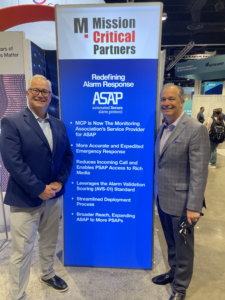 The Monitoring Association (TMA) announced today that the Tampa (Florida) Police Department (TPD) recently implemented its ASAP Service to lessen the impact of alarm/sensor-generated calls that its 911 Communications Center receives. The solution leverages the Automated Secure Alarm Protocol (ASAP), which was developed jointly by TMA and the Association of Public-Safety Communications Officials (APCO). TPD is the 150th ECC to go live with ASAP.
The Monitoring Association (TMA) announced today that the Tampa (Florida) Police Department (TPD) recently implemented its ASAP Service to lessen the impact of alarm/sensor-generated calls that its 911 Communications Center receives. The solution leverages the Automated Secure Alarm Protocol (ASAP), which was developed jointly by TMA and the Association of Public-Safety Communications Officials (APCO). TPD is the 150th ECC to go live with ASAP.
Each year, the center handles about 300,000 calls for emergency service and dispatches the appropriate police, fire/rescue, and/or emergency-medical response. Roughly 20,000 of these calls are generated by alarms and sensors.
Traditionally, alarm/sensor-generated alerts have been delivered to 911 centers via telephone. Each one required manual interaction between alarm-monitoring-center personnel and 911 telecommunicators. Sometimes it takes as many as five voice calls to deliver the information needed by the 911 center to dispatch the appropriate emergency response. This approach is time-consuming and prone to human error — both outcomes are highly detrimental to the ability of emergency responders to save lives and property.
ASAP Service eliminates these challenges by electronically transmitting alarm and sensor data directly into the 911 center’s computer-aided-dispatch (CAD) system, reducing response times by two minutes on average and freeing telecommunicators to prioritize 911 calls that require their unique skills and expertise.
This is especially important given how TPD’s 911 Communications Center operated before the advent of ASAP Service, according to Richard Parsons, communications supervisor. Unlike other 911 centers, alarm and sensor calls came into the center on a 911 line, rather than a nonemergency administrative line. Consequently, those calls went into the same call-waiting queue that contained calls that were reporting medical emergencies, crimes, car accidents, structure fires, and the like.
“So, someone having a heart attack might have to wait for a telecommunicator to finish handling a call that was triggered by an animal tripping a motion detector before getting the lifesaving help they need,” Parsons said. “ASAP Service eliminates that problem.”
According to Mike Terracciano, public-safety-technology manager for the city of Tampa, telecommunicators are trained to ask only those questions that will enable them to quickly determine the best response to the emergency. As a result, useful information that the alarm company possesses for each of its clients typically went untapped.
“Now, with ASAP Service, that supplemental information — which might ring important from a responder-safety perspective — is readily available and easily accessed,” Terracciano said.
Learn more about how TMA’s ASAP Service is saving lives every day nationwide at www.ASAP911.org.
About Tampa 911 Communications Center
The 911 Communications Center receives requests for emergency and nonemergency services from the public and various city agencies. The center’s primary mission is to provide effective and efficient communication between citizens requesting police, fire/rescue, and/or emergency-medical service and the units that respond. It also endeavors to expeditiously provide various other support services for police, fire, and administrative operations.



 ASAP eliminates the need for traditional phone calls to 911 centers by securely transmitting crucial alarm information, such as the type of emergency, address, and contact details, instantly and precisely. This streamlined communication accelerates dispatching public safety agencies, improves accuracy, reduces call volume at 911 centers, and minimizes the potential for miscommunication. Moreover, it enables real-time status updates between COPS and participating PSAPs, promoting enhanced collaboration between monitoring professionals and first responders.
ASAP eliminates the need for traditional phone calls to 911 centers by securely transmitting crucial alarm information, such as the type of emergency, address, and contact details, instantly and precisely. This streamlined communication accelerates dispatching public safety agencies, improves accuracy, reduces call volume at 911 centers, and minimizes the potential for miscommunication. Moreover, it enables real-time status updates between COPS and participating PSAPs, promoting enhanced collaboration between monitoring professionals and first responders. The estimate is based on an average savings of two minutes per call for 12,231 alarm notifications processed via ASAP Service in 2024, bypassing the traditional multiple voice calls required to gather dispatch and response details.
The estimate is based on an average savings of two minutes per call for 12,231 alarm notifications processed via ASAP Service in 2024, bypassing the traditional multiple voice calls required to gather dispatch and response details. The Monitoring Association (TMA) announced today that the Tampa (Florida) Police Department (TPD) recently implemented its ASAP Service to lessen the impact of alarm/sensor-generated calls that its 911 Communications Center receives. The solution leverages the Automated Secure Alarm Protocol (ASAP), which was developed jointly by TMA and the Association of Public-Safety Communications Officials (APCO). TPD is the 150th ECC to go live with ASAP.
The Monitoring Association (TMA) announced today that the Tampa (Florida) Police Department (TPD) recently implemented its ASAP Service to lessen the impact of alarm/sensor-generated calls that its 911 Communications Center receives. The solution leverages the Automated Secure Alarm Protocol (ASAP), which was developed jointly by TMA and the Association of Public-Safety Communications Officials (APCO). TPD is the 150th ECC to go live with ASAP. Over the course of the multi-day education and networking event, Butkovich and Reilly met with NENA leadership and volunteers in addition to 9-1-1, public safety leaders, CAD vendors, and telecommunication companies to share and discuss the vision and future goals for TMA’s ASAP protocol.
Over the course of the multi-day education and networking event, Butkovich and Reilly met with NENA leadership and volunteers in addition to 9-1-1, public safety leaders, CAD vendors, and telecommunication companies to share and discuss the vision and future goals for TMA’s ASAP protocol.





